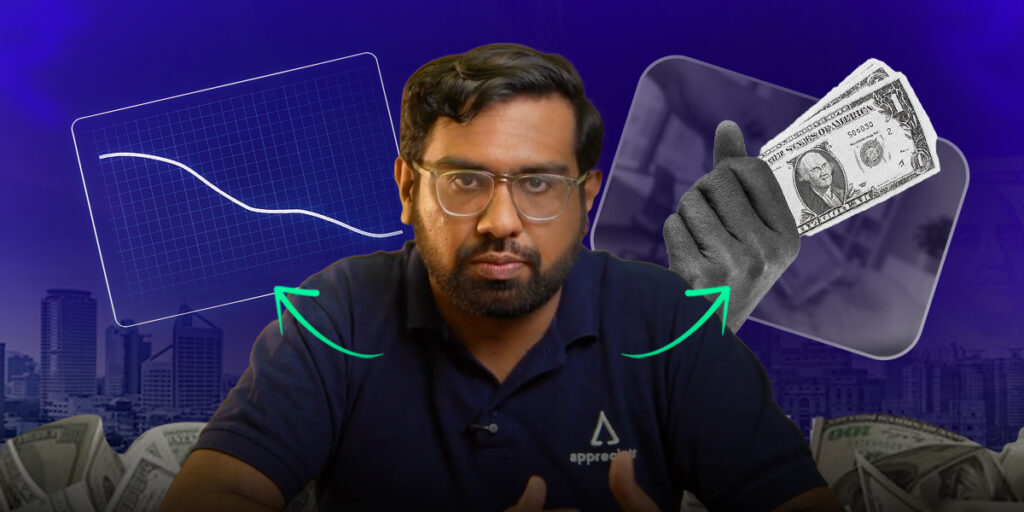Introduction
The financial markets are no strangers to volatility. The global economy is unpredictable, with policy changes and market shifts happening constantly. For investors, staying steady means having a plan that works even when things change. One of the most effective tools to achieve this balance is through global exchange-traded funds (ETFs). These investments can protect your portfolio during market drops and enhance your gains when the market is rising. Platforms like Appreciate make it easier than ever for Indian investors to access and invest in US-listed ETFs, bringing global diversification right to your fingertips.
In this article, we’ll look at different types of US ETFs. We’ll explore how Volatility, Short, and Leveraged ETFs can help you navigate market ups and downs.
Understanding ETFs and their Role
ETFs are investment funds traded on stock exchanges that hold a basket of assets from markets around the world. Unlike individual stocks, ETFs offer instant diversification. They spread your investments across sectors, countries, and asset classes, which helps reduce risk. This is especially helpful during uncertain times. It can soften the blow from geopolitical tensions, economic changes, or trade issues.
ETFs offer more than diversification. They come in different forms and are designed to perform based on market conditions. Some ETFs perform well when markets drop, a few do better during rallies. Others profit from volatility. This flexibility makes them powerful for investors. They help protect capital while also pursuing growth.
ETFs can help create a dynamic strategy that adapts to market changes. Instead of reacting to them, you can stay ahead. Let’s look at three types of ETFs listed in the US markets – Volatility, Short, and Leveraged ETFs.
Volatility ETFs: Hedging Against Market Fear
Volatility ETFs are typically designed to increase in value when fear and uncertainty grip the markets. These ETFs track volatility indexes such as the VIX, commonly known as the “fear gauge” of the market. When investors expect turbulence, volatility usually rises. These ETFs can help protect against falling asset prices.
For example, the ProShares Ultra VIX Short-Term Futures ETF (UVXY) has gained an impressive 89% YTD as of April 14, 2025. Similarly, the 2x Long VIX Futures ETF (UVIX) has surged by 91% over the same period. These ETFs are useful during sudden market drops or times of uncertainty, like crises or unexpected news.
However, it’s important to note that volatility ETFs are generally not long-term holds. They can be highly volatile themselves, often experiencing rapid price swings. Investors typically use them as short-term hedges or trading tools to capitalize on spikes in market fear.
Short ETFs: Protecting Your Portfolio When Markets Fall
Short ETFs, or inverse ETFs, move opposite to the underlying index or asset. When the market falls, these ETFs go up in value, acting like insurance against losses. They’re especially useful during bear markets or corrections when regular investments may lose value. However, it’s important to note that inverse ETFs reset their exposure daily, which means their performance over longer periods can differ from the exact inverse of the underlying index due to compounding effects.
Two notable examples available on Appreciate include the ProShares UltraPro Short S&P 500 ETF (SPXU) and the ProShares UltraPro Short QQQ ETF (SQQQ). SPXU has gained 59% from January 1 to April 8, while SQQQ is up 75% over the same period. These returns are largely driven by the market downturn following the US tariff announcements, particularly the April 7 announcement, which caused significant market declines.
Short ETFs can be an effective way to balance your portfolio during uncertain times. Allocating a portion of your investments to these funds can help offset losses in other areas, reducing overall portfolio volatility. However, like volatility ETFs, short ETFs are meant for short-term use. Due to daily rebalancing and compounding effects, they may not suit long-term strategies.
Leveraged ETFs: Amplifying Gains in Bull Markets
When markets are bullish, long ETFs can help investors amplify their returns. These ETFs employ leverage of 2x or 3x to maximize the performance of an underlying index. This allows investors to benefit more from market upswings. While they carry higher risk, their potential for large gains makes them appealing during market rallies.
For instance, the ProShares UltraPro S&P 500 ETF (UPRO) has delivered a remarkable 231% gain over the past five years, as of April 14. Similarly, the ProShares UltraPro QQQ ETF (TQQQ) has grown by 191% during the same period. These leveraged ETFs track major indices like the S&P 500 and Nasdaq 100, providing exposure to some of the largest and most influential companies globally.
Leveraged ETFs are ideal for investors with a higher risk tolerance who want to capitalize on bullish trends. They can be used to increase portfolio returns when economic indicators and market sentiment are positive. It’s important to monitor these investments closely. Leverage can magnify both gains and losses, especially during market downturns.
Conclusion
Market ups and downs are inevitable, but how you prepare for them can make all the difference in your investment journey. Global ETFs give you a powerful and flexible way to navigate market volatility—volatility ETFs help hedge against fear, short ETFs offer protection during downturns, and long ETFs aim to amplify gains in bullish markets.
By understanding these ETF types, you can build resilience against uncertainty and take advantage of growth opportunities. Remember, no investment is foolproof. Diversification and regular portfolio management remain essential for long-term success.
Find volatility, short, and long ETFs tailored to your goals on the Appreciate app. Download it from the Google Play Store today, to build a portfolio that adapts to market cycles.
Disclaimer: Investments in securities markets are subject to market risks. Read all the related documents carefully before investing. The securities quoted are exemplary and are not recommendatory.























